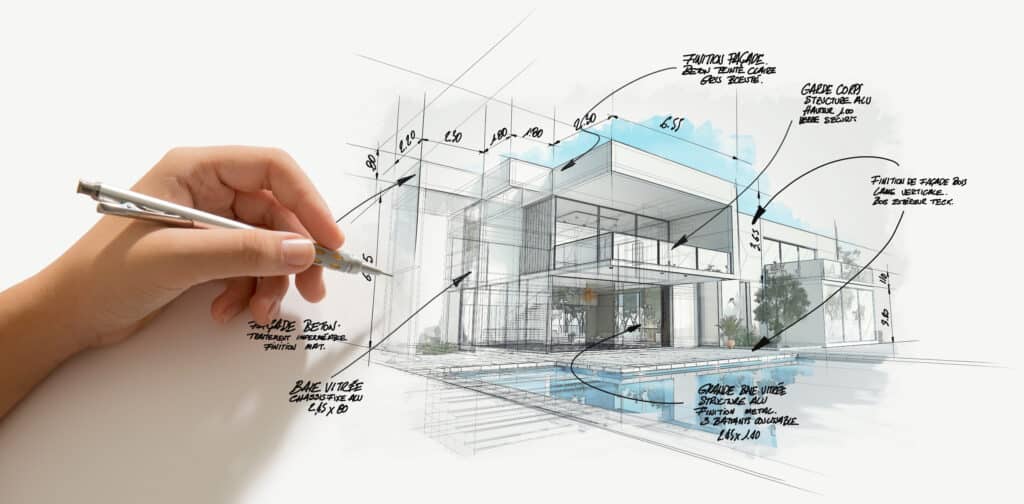Architect Marketing Strategies to Engage Luxury Clients
Architect Marketing Strategies to Engage Luxury Clients
Blog Article
Comprehending the Diverse Occupation Paths Available for Aspiring Architect
As a hopeful Architect, you have a globe of job paths waiting for you. Each path offers special obstacles and possibilities to use your imagination and technical expertise. Whether you're drawn to conventional style or the subtleties of lasting design, there's a niche that aligns with your rate of interests. Comprehending these varied alternatives can form your professional trip, but which direction will you choose to check out initially?
Traditional Design: Designing Buildings and Structures
Traditional design focuses on designing structures and structures that blend functionality with aesthetic charm. As you discover this area, you'll appreciate the detailed equilibrium in between kind and function. You'll find out to draw motivation from historic designs, integrating aspects like symmetry, materials, and craftsmanship. Your styles can reflect cultural heritage, showcasing regional traditions while satisfying contemporary needs.
You'll establish skills in composing, model-making, and website analysis, allowing you to picture and communicate your ideas properly. Involving with clients, you'll need to recognize their vision and translate it right into viable styles.
Furthermore, building codes and sustainability techniques are important in your job, guaranteeing your frameworks are safe and eco friendly. As you expand in your career, you'll find opportunities in household, commercial, or perhaps reconstruction jobs, each offering unique obstacles. Embracing standard design leads the way for a satisfying career that pays homage to the past while forming the future.
Urban Preparation: Forming Neighborhoods and Public Spaces
As an ambitious Architect, you can play an important role as a city planner, changing exactly how communities work and communicate. By utilizing neighborhood interaction methods, you'll guarantee that locals have a voice in forming their setting. Plus, integrating sustainable layout concepts will aid develop spaces that not just satisfy today's needs yet likewise protect the future.
Function of Urban Planners
While numerous may assume of engineers as the single dreamers behind buildings, city organizers play a necessary role in shaping the more comprehensive landscape of neighborhoods and public areas. By working together with various stakeholders, you'll aid create parks, transport systems, and domestic areas that promote social interaction and accessibility. Your experience in spatial style and area characteristics allows you to visualize future growth while protecting cultural heritage.
Community Engagement Approaches
Effective community interaction methods are essential for metropolitan organizers to assure that the voices of residents are listened to and valued in the planning process. To foster purposeful dialogue, you need to focus on open forums and workshops where community participants can reveal their ideas and worries. By actively incorporating and listening feedback, you'll produce rooms that show the neighborhood's requirements, eventually leading to more sustainable and successful city atmospheres.
Sustainable Layout Concepts
When creating city areas, including sustainable layout concepts is important for creating environments that grow both environmentally and socially. Consider integrating environment-friendly rooms, like parks and yards, to boost biodiversity and improve air quality.
Creating with water conservation in mind is likewise essential-- assume regarding rain gardens and permeable surface areas to handle stormwater. Including neighborhood members throughout the preparation procedure guarantees that the areas you create meet their demands and encourage social interaction. By welcoming these concepts, you'll add to vivid, lasting urban landscapes that profit everyone.

Landscape Architecture: Creating Lasting Outdoor Settings
As you discover landscape architecture, you'll uncover necessary design principles that create useful and attractive outdoor spaces. Sustainable methods play a vital role in making certain these settings thrive while decreasing ecological impact. Plus, you'll discover a range of career chances that permit you to make a real difference in how individuals communicate with nature.
Design Principles in Landscape
Comprehending design principles in landscape architecture is important for developing lasting outdoor settings that harmonize with nature. You'll require to consider components like balance, scale, and percentage to ensure your styles really feel cohesive and welcoming. Including indigenous plants not just enhances biodiversity but likewise decreases water use, making your landscape durable. Consider the circulation of room and how people interact with it; paths and seating areas must invite expedition and leisure. In addition, take note of seasonal modifications, designing with materials that match the environments year-round (Architect). By prioritizing sustainability and aesthetics, you can create exterior spaces that enhance the area and promote wellness. Embracing these concepts will set a solid foundation for your career in landscape style.
Sustainable Practices Introduction
Lasting practices in landscape style not only concentrate on appearances yet likewise focus on ecological health and wellness and source preservation. By incorporating indigenous plants, you improve biodiversity and decrease the need for chemical fertilizers and pesticides. Executing effective watering systems helps conserve water and minimizes overflow, safeguarding neighboring environments. You can develop spaces that promote dirt health and wellness, such as utilizing organic materials and exercising permaculture principles. Additionally, incorporating green facilities, like rain yards and permeable pavements, help in stormwater administration and reduces metropolitan heat. When you develop exterior settings with sustainability in mind, you add to a healthier world and offer spaces that promote neighborhood link. Ultimately, these methods guarantee your layouts profit both individuals and the setting for years ahead.
Career Opportunities Expedition
With a strong foundation in sustainable practices, landscape style offers a range of profession courses that enable you to make a purposeful impact on the environment. Urban coordinators typically team up with landscape engineers to produce eco-friendly rooms in metropolitan setups, improving city livability. If you're passionate concerning education, take into consideration ending up being a landscape architecture instructor, Architect motivating future generations.
Sustainable Style: Concentrating On Eco-Friendly Practices
As you explore your occupation in more info architecture, embracing green techniques can set you apart in an affordable field. Lasting style concentrates on creating structures that reduce environmental effect while improving owner well-being. By integrating renewable materials, energy-efficient systems, and sustainable structure methods, you'll add to a greener future.
Begin by gaining understanding of green certifications like LEED or BREEAM, which can bolster your qualifications. Consider just how all-natural light, ventilation, and thermal efficiency can enhance layout. Collaborate with designers and environmental professionals to innovate solutions that reduce waste and conserve sources.
Do not neglect the relevance of neighborhood involvement-- engaging local stakeholders can inspire designs that harmonize with the environment. As customers increasingly focus on sustainability, your know-how in environmentally friendly methods will certainly not only draw in jobs however likewise satisfy your enthusiasm for responsible design. Accept this vital facet of the career, and see your occupation flourish.
Historical Preservation: Safeguarding and Recovering Social Heritage
While you start on your architectural trip, think about the important function of historic preservation in maintaining our cultural heritage. This area concentrates on the defense and repair of significant structures, sites, and frameworks that inform the stories of our past. By engaging in historical preservation, you'll assist safeguard the building legacy that forms area identity.
As a historical conservation Architect, you'll examine historical relevance and analyze the problem of structures. You'll function closely with conservationists and historians to ensure genuine remediation strategies are employed. This job course enables you to mix imagination with study, enabling you to develop options that value initial materials and workmanship.
Your job not only adds to sustainability by reusing existing structures but additionally cultivates a feeling of pride within communities. Embracing this path will certainly help you end up being a guardian of background, preserving the tales and aesthetic appeals that enrich our lives.
Interior Architecture: Enhancing Indoor Spaces
Historical preservation and interior style both share a commitment to enhancing the constructed setting, but they focus on various aspects. While historic preservation highlights preserving a framework's social and historic worth, indoor architecture absolutely nos in on enhancing indoor areas for performance and visual appeals.
As an aspiring Architect, you'll locate that interior style enables you to blend creative click here thinking with technical skills. You'll develop rooms that not only look great but additionally promote comfort and effectiveness. This field involves understanding exactly how light, color, and products interact within an area, impacting mood and use.
You'll service numerous tasks, from household homes to business workplaces, ensuring that each setting fulfills the requirements of its occupants. By prioritizing customer experience, you can transform insides right into useful and inspiring areas, making a considerable influence on exactly how individuals connect with their environments. Welcome the possibility to boost indoor environments and form the means individuals function and live.
Industrial Design: Combining Functionality With Appearances
Industrial design plays a crucial function in creating products that effortlessly blend appearances with functionality, guaranteeing that what you use daily is not just visually enticing yet also functional. As an ambitious Architect, you can immerse on your own in this area, concentrating on developing everything from furnishings to customer electronic devices. Your work involves comprehending individual demands, products, and making processes, enabling you to create innovative remedies that enhance day-to-day experiences.
In industrial layout, you'll often team up with makers, designers, and marketing experts, ensuring that your layouts are not only beautiful however likewise possible. This job path provides a dynamic environment where imagination meets usefulness, making it a fulfilling option for architects interested in forming the items of tomorrow.
Regularly Asked Concerns
What Educational Credentials Do I Required to Come To Be an Architect?
To become an engineer, you'll need a professional degree in architecture, normally a Bachelor's or Master's. Furthermore, you'll have to finish a teaching fellowship and pass the Architect Enrollment Exam to exercise lawfully.
Exist Qualification Demands for Different Building Occupation Paths?
Yes, there're qualification needs for various architectural courses. Architect. You'll need to pass exams, full internships, and occasionally seek specialized training, relying on your picked emphasis, like landscape style, city layout, or historic conservation
What Software Application Abilities Are Important for Engineers Today?

How Can I Gain Practical Experience While Studying Architecture?
You can gain sensible experience by interning at building companies, joining design competitions, volunteering for area jobs, or collaborating with classmates on real-world jobs. These possibilities boost your abilities and construct beneficial links in the market.
What Job Opportunities Exist Outside Standard Style Firms?
You can check out different task chances outside traditional architecture firms, like urban preparation, interior decoration, landscape architecture, construction monitoring, realty advancement, or also roles in sustainability consulting. Each deals unique difficulties and rewards.
Whether you're drawn to standard design or the subtleties of sustainable design, there's a niche that aligns with your interests.When designing urban areas, incorporating sustainable layout principles is crucial for creating settings that grow both ecologically and socially.As you check out landscape style, you'll discover important layout principles that produce functional and stunning outdoor rooms.Understanding style principles in landscape architecture is vital for creating sustainable exterior environments that integrate with nature.In commercial layout, you'll typically work together with engineers, suppliers, and marketing experts, ensuring that your styles are not only gorgeous yet also possible.
Report this page